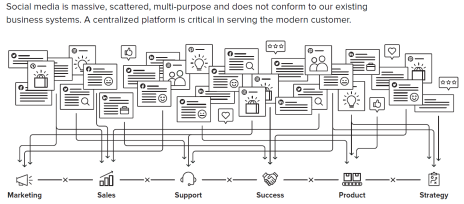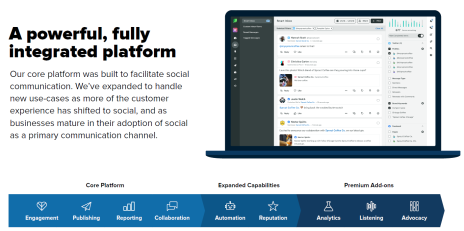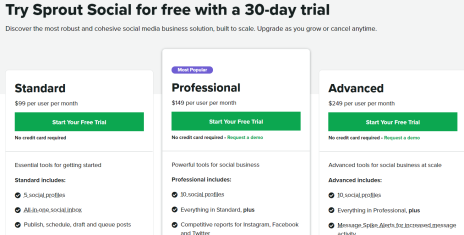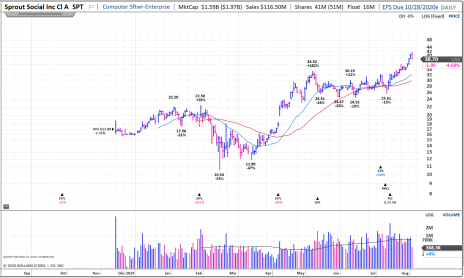This month we’re jumping back into the pure-play software space with an up and coming SaaS company that has remained under the radar since going public in December, just a few months before the market tanked.
It specializes in social media management solutions, which are increasingly important as the trend toward digital transformation strategies gets stronger. Organizations increasingly recognize they must market to consumers through social networks.
Revenue growth is hovering around 30% and first profits are still a couple years away, meaning we’re still early to the table.
All the details are inside this month’s Issue. Enjoy!
Cabot Small Cap Confidential 256
[premium_html_toc post_id="213701"]
The Big Idea
In the early days of social media people mostly wanted to connect with friends and family members to share stories and a few pictures about their lives. There were also those that wanted to network with colleagues and make connections to help land that next dream job.
Early platforms, such as Facebook (FB), Twitter (TWTR) and LinkedIn, which all sprung up in the first five years of the 2000s, helped to facilitate these types of communications and sharing of common interests.
It seemed like a no-brainer for consumers. But of course, these platforms weren’t just giving away a tool for people to connect with no strings attached.
Forward-thinking businesses realized the immense power and opportunity represented by social media data. If they could entice users to flock to their platforms they could collect billions of data points, then leverage it to entice brands to advertise with them.
It worked. The digital distribution model of social networks created an entirely new channel through which brands could connect with customers in an authentic way and at a scale that was previously inconceivable.
That was the beginning of social media advertising, and it changed the world.
Today, you can hardly get away from social media unless you eschew digital devices altogether. While there is some blowback to the practice of companies collecting user data and sharing it with marketers, it is trumped by people’s desire to use these platforms. And there are more than a few consumers that are glad to share the data because they get targeted offers for goods and services they didn’t previously know about, or had trouble finding.
Social media is a game changer for businesses, but also for cultures, often helping shape perception of communities, companies and the broader world. It creates a feedback loop and helps hold organizations accountable. It allows unprecedented sharing of ideas, experiences and criticisms. It empowers individuals by giving them a voice over new communication channels.
Most relevant to today’s discussion, there continues to be enormous potential for using social media as a source of business intelligence.
I’ve written many times that organizations that don’t develop a digital strategy quickly will wither and die, and social media is part of that, for better or worse.
It’s estimated that there are well over three billion users and 90 million businesses currently using social media. There are tons of platforms, and monitoring incoming and outgoing messages can get overwhelming very quickly, especially for organizations that are launching new products and services.
Managing social media has become a profession unto itself, often falling on the shoulders of marketing and customer service departments. But doing so properly means specialized tools—there are just too many networks and too many conversations for a fragmented approach to work.
Today we’re investing in a company that specializes in software for social media management. It’s only a decade old and is still relatively small, with a market cap of roughly $2 billion. It’s also the only pure-play social media software management company that’s publicly traded.
Revenue growth is tracking around 30% and demand remains strong even in the current climate, while profitability remains at least a couple years away. That all means we’re still early and the best is likely yet to come.
The Company
Sprout Social (SPT) is a Chicago, Illinois-based software company that offers cloud-based social media management solutions for companies of all sizes, from small businesses with a few employees to enterprises with thousands.
The company’s suite of social management, analytics, customer care, advocacy and deep listening solutions help brands drive more authentic connections with people through social channels.
It has relationships with Facebook (FB), Instagram, Pinterest (PINS), Twitter (TWTR), Google (GOOGL) and LinkedIn, among others. These relationships, combined with innovative solutions (built from a single code-base) that are comprehensive and easy to deploy and use have helped Sprout rise to the top in its specialized industry.
The company was founded in 2010 by Aaron Rankin, Gil Lara, Justyn Howard and Peter Soung. In the early days the platform simply facilitated social communications. Over the last decade, and especially since 2018, Sprout Social has evolved into a more comprehensive set of offerings that business users typically spend more than half their time working with.
While the single code base makes for efficient product development and easy implementations – customers can essentially turn it on or off with the click of a button – Sprout’s products are powerful and capable of handling complex communications occurring billions of times a day across multiple platforms and formats.
The company currently has 24,356 customers across market segments (small business, mid-market, enterprise, government, non-profit, etc.). Recent customer wins include Verizon Media, Eventbrite (EB), Curaleaf (CURLF), Bill.com (BILL), GitHub and Autodesk (ADSK). While there was some drop off in customers in March and April, especially in the SMB and agency segments, the trend has since reversed and June showed the lowest month of customer cancellations in two years.
It’s easy to see why both large and small customers are finding value in the platform. Sprout Social is easy to start using (just a couple of hours to get started) has very reasonable prices (starting at $99) and makes life easier, aggregating disparate social media communications into a single unified system of record.
This simplified approach helps organizations better understand, reach and communicate with customers. That leads to better business decisions and financial performance.
Despite tremendous success over the last decade, Sprout Social is still in the early stages of its growth journey. Industry analysts believe the current market opportunity in the U.S. is at least $13 billion. Globally, it’s likely $25 billion or more. More aggressive estimates peg the opportunity closer to $50 billion.
Either way, Sprout has a lot of room to grow.
Products & Platform
Sprout Social’s platform offers customers a selection of solutions based on their needs and budget.
There are four components of the Core Platform: Engagement, Publishing, Reporting and Collaboration. Two solutions – Automation and Reputation – are offered as expanded capabilities, and three solutions – Analytics, Listening and Advocacy – are offered as premium add-ons.
Here are descriptions of a few of these modules.
Engagement: Engagement tools help organizations efficiently and effectively respond to all the messages coming in across social platforms, which have largely replaced telephone and email for many customer interactions. Tools include smart inbox, social CRM and automation.
Publishing: Organizations can collaborate using Sprout Social’s publishing tools to publish effective and compelling content on social media. Tools include an intuitive publishing interface, calendar and campaign organization solutions, and automation, reporting and suggested content solutions.
Analytics: Premium Analytics helps customers gain even more insight into what’s working and what’s not when it comes to brand management. Social data reporting can be tailored to reflect detailed metrics such as likes, comments and shares.
Listening: Hundreds of millions of data points are created on social networks daily and understanding what’s trending, and what’s not, can help organizations better understand their market, customers and competition. Sprout Social’s tools give insights into market research, brand health, competitive positioning and product feedback.
Growth Initiatives
Upsell Current Customers: Sprout Social’s strategy for monetizing customers is common for software companies; bring them in with something they need and then sell them more of what they need once they realize the value. The company’s Listening solution, released in 2018, has been one success story. Customers that have adopted Listening have increased their average contract value more than six-fold over the last four years. Listening now drives over $10 million of annual recurring revenue, equal to roughly 10% of 2019 revenue.
Develop New Solutions: Sprout Social has one of the biggest independent sources of consumer social media data out there. Armed with this asset the company can continue to develop new solutions and expand into new markets to fuel growth. The latest example of new product development is the Reputation Management solution, which surpassed 1,000 customers in its first month.
International Expansion: In 2019 Sprout generated almost 30% of revenue from customers outside of the U.S. Social media has been and will continue to be a global movement and brands are increasingly targeting consumers in international markets. Specifically, Sprout is investing in Europe, Australia and New Zealand.
The Business Model
Sprout Social has a straightforward SaaS business model. Customers initially get a 30-day free trial then are offered an upgrade to a paid plan based on their needs. Subscription fees are based on the plan selected and number of users. Over time Sprout tries to upsell customers to purchase additional solutions (i.e. Listening).
New contracts are structured as either monthly (30%) or annual (70%). There are essentially no professional services needed as everything is cloud-based, so 99% of revenue comes from subscriptions. Sprout’s inbound type of sales model (digital marketing drives potential customers to Sprout’s website) is very efficient.
The Bottom Line
Sprout Social grew 2019 revenue by 30% to $102.7 million. Earnings per share was -$0.95. Revenue growth in Q1 was 31% before dipping modestly, to 27%, in Q2. The trend in EPS losses continued to improve with adjusted EPS coming in at -$0.14 in Q1 and -$0.11 in Q2 (both EPS results beat expectations).
Taking it all in analysts see the company growing 2020 revenue by 27% to $130 million (the high end of management guidance, which I expect is conservative) and delivering a 47% improvement in adjusted EPS, which is seen near -$0.50. Growth should accelerate in 2021 with revenue up 31% while expected EPS of -$0.38 suggests the positive trend toward breakeven will continue.
Sprout Social ended Q2 with $129.5 million in cash. Subsequent to the end of the quarter the company completed a stock offering of Class A shares, which did not raise capital for the company but does help diversify the investor base.
On the Q2 earnings call, management was largely positive about the business and noted significant improvements in customer churn month-over-month in May and June and continuing into July. Inbound sales volumes were above historical levels and conversions (trial to paid) are also tracking in the right direction. Critically, premium modules Listening and Analytics grew by well over 100%, while attracting larger customers. This suggests good things for the future as selling more solutions to larger customers is key to the long-term growth story.
Finally, management noted that Sprout landed 273 net new customers in Q2 and that 140 new customers pushed above the $10,000 annual contract value (ACV) threshold. Price concessions to current customers were also smaller than previously expected.
Risk
Reliance on Inbound Interest To Fuel Sales: Sprout’s sales strategy of attracting customers through unpaid channels, offering a trial then converting to paid, is very efficient, but also reliant on inbound marketing strategies. Should inbound interest drop off or customers need more contact with a salesperson, Sprout may have to invest more rapidly in an outbound sales strategy.
Data Privacy: Changes in laws and regulations related to the internet, privacy, data protection and information security could impact Sprout’s ability to source and share data and/or increase the costs of doing so.
Brand Reputation: Brand power is everything in social media. As a provider of tools to help customers manage their brand, it is essential that Sprout Social keep its own brand well-polished. Any significant data breach, operational failure or other significant event that tarnishes the company’s brand could adversely affect revenue.
Lack of Profitability: Sprout Social will not be profitable for several years. This could hold the stock back if investors become more risk averse. That said, we’ve often seen that investing in software stocks in this pre-profitability stage has worked out well.
Inability To Attract Larger Customers: Sprout Social needs to continue growing in the corporate and enterprise markets where pricing power and contract values are more significant than in the small business market, which is good but can only carry the company so far.
Competition
There are several larger companies that offer social media monitoring solutions through more expansive software platforms, including Salesforce (CRM) and Adobe (ADBE). Sprout Social’s direct competition most likely comes from privately held Hootsuite, Khoros and Sprinklr, however, as these are the companies for which customers can go out and buy a single point solution to handle their social media management needs.
The Stock
Trading Volume: SPT trades an average of 730,000 shares daily. Heavy days see volume north of 1 million shares and there have been 16 of those in the last six months, mostly around events that you’d expect to drive higher volume (earnings, IPO lockup expiration, secondary offering).
Historical Price: SPT came public on December 13, 2019 at 17 and initially did nothing, then moved into the mid-20s before falling 53% during the March 2020 market crash. Shares recovered with the market, than gapped up to their previous high near 22.5 after Q2 2020 results came out in May 6. The stock kept marching higher and reached 33.5 on June 5. SPT then retreated 25% and spent the next two months consolidating in the 25 to 32.5 range. A secondary offering priced at 27.5 was quickly absorbed in August and shares broke out to fresh highs on August 21. They trended higher and peaked just shy of 42 on Tuesday before beginning to pull back.
Valuation & Projected Price Target: SPT trades with a 2021 EV/Revenue multiple near 11.7. That’s a record valuation for this stock but it’s still considerably lower than the SaaS average, which is closer to 14.5. Over time that discount should evaporate if/as the fundamentals improve (especially profitability). Applying the average multiple implies roughly 25% upside (to 50) whereas applying a multiple closer to the high growth SaaS premium (near 20) implies roughly 70% upside (to 68). Let’s go with a price target of 55 for now (38% upside).
Buy Range: The most likely near-term buy range (next two weeks) will be above the previous high of 33.5 but below the most recent spike to 42. Average in and look to make bigger purchases in the mid-30s and smaller ones around 40.
The Next Event: Third quarter 2020 earnings are expected around October 28.
Updates on Current Recommendations
| Stock Name | Date Bought | Price Bought | Price on 9/2/20 | Profit | Rating |
| Accolade (ACCD) | 8/6/20 | 40.09 | 34.47 | -14% | Buy a Half |
| AppFolio (APPF) | 6/2/17 | 30.45 | 168.25 | 453% | Hold |
| Arena Pharmaceuticals (ARNA) | 2/2/18 | 38.93 | 67.62 | 74% | Buy |
| Avalara (AVLR) | 2/1/19 | 40.05 | 136.08 | 240% | Hold |
| Cardlytics Inc (CDLX) | 9/6/19 | 37.97 | 77.82 | 105% | Buy |
| Everbridge (EVBG) | 12/2/16 | 15.51 | 148.71 | 859% | Hold |
| EverQuote (EVER) | 6/7/19 | 11.69 | 41.04 | 251% | Buy |
| Fiverr Intl (FVRR) | 3/5/20 | 32.32 | 117.04 | 262% | Hold 3/4 |
| Goosehead Insurance (GSHD) | 9/7/18 | 31.35 | 112.50 | 259% | Hold 3/4 |
| Inspire Medical (INSP) | 10/4/19 | 58.54 | 125.15 | 114% | Buy |
| Karyopharm Therapeutics (KPTI) | 5/7/20 | 19.49 | 15.69 | -19% | Hold |
| Palomar Holdings (PLMR) | 6/4/20 | 82.34 | 119.24 | 45% | Buy |
| Q2 Holdings (QTWO) | 4/1/16 | 23.81 | 99.63 | 318% | Buy |
| Repay Holdings (RPAY) | 7/2/20 | 25.04 | 25.95 | 4% | Buy |
| Repligen (RGEN) | 11/2/18 and 12/31/18 | 59.19 | 156.06 | 164% | Buy |
Please email me at tyler@cabotwealth.com with any questions or comments about any of our stocks, or anything else on your mind.
Glossary
Buy means accumulate shares at or around the current price.
Hold means just that; hold what you have. Don’t buy, or sell, shares.
Sell means the original reasons for buying the stock no longer apply, and I recommend exiting the position.
Sell a Half means it’s time to take partial profits. Sell half (or whatever portion feels right to you) to lock in a gain, and hold on to the rest until another ratings change is issued.
The next Cabot Small-Cap Confidential issue is scheduled for October 1, 2020.
Cabot Wealth Network
Publishing independent investment advice since 1970.
CEO & Chief Investment Strategist: Timothy Lutts
President & Publisher: Ed Coburn
176 North Street, PO Box 2049, Salem, MA 01970 USA
800-326-8826 | support@cabotwealth.com | CabotWealth.com
Copyright © 2020. All rights reserved. Copying or electronic transmission of this information is a violation of copyright law. For the protection of our subscribers, copyright violations will result in immediate termination of all subscriptions without refund. No Conflicts: Cabot Wealth Network exists to serve you, our readers. We derive 100% of our revenue, or close to it, from selling subscriptions to its publications. Neither Cabot Wealth Network nor our employees are compensated in any way by the companies whose stocks we recommend or providers of associated financial services. Disclaimer: Sources of information are believed to be reliable but they are not guaranteed to be complete or error-free. Recommendations, opinions or suggestions are given with the understanding that subscribers acting on information assume all risks involved. Buy/Sell Recommendations: All recommendations are made in regular issues or email alerts or updates and posted on the private subscriber web page. Performance: The performance of this portfolio is determined using the midpoint of the high and low on the day following the recommendation. Cabot’s policy is to sell any stock that shows a loss of 20% in a bull market or 15% in a bear market from the original purchase price, calculated using the current closing price. Subscribers should apply loss limits based on their own personal purchase prices.









